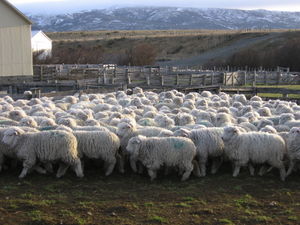Advertisement
Published: August 11th 2007

 Sea of Sheep in Tierra Del Fuego
Sea of Sheep in Tierra Del Fuego
It should be Tierra Del Obejas (The Land of Sheep) as we soon learned after visiting this Estancia on the island. We had never seen so many sheep. Over 5000 of them in total!Well, folks, we thought that Punta Arenas was the end of the world with it´s freezing temperatures, hurricane force winds and high prices on everything except alcohol (we heard... not from personal experience, of course), but we were treated to an expedition to work on a sheep farm on the island of Tierra del Fuego (The ¨Land of Fire¨) for the last few days and it made Punta Arenas look like New York City. The Magallenas region of Chilean Patagonia historically owes its prosperity to two industries; Shipping and sheep farming. The cold temperatures and high winds year round mean that not much will grow in the volcanic soil of the region except scrub and low grasses, but when sheep were brough here 150 years ago they thrived and grew thick wool that became the region´s main resource. For hundreds of years the Straight of Magellan was used as a the only access for ships wishing to travel from Europe to the west coast of the Americas, and Punta Arenas was the port at the southern tip where the ships made port; however, with the opening of the Panama Canal, much of the trade to this region stopped. Now sheep and

 Herding the sheep for shearing
Herding the sheep for shearing
Emma helping to herd the sheep into the barn for their annual pre-lambing shearing.recent oil deposits along with tourism fuel the Magallean economy. We visited with Rodrigo Filipic, a young sheep farmer who lives about 50 kms outside of the port town of Porvenir on Tierra del Feugo. He owns 5000 sheep and 100 Hereford cattle on approximately 100,000 hectares of land and farms them with a ¨hands off¨ philosophy. Because this is the middle of Chilean winter (think february in southern Ontario), there is not much to be done with the animals currently; however, we were able to help Rodrigo and his workers to gather, shear and give antiparasitic treatments to approximately 1500 animals that will be lambing in 2 months time. The faces and back ends of the animals are shorn so that they can see and that the valuable wool does not get dirtied by the birthing process in the spring and it was amazing to see how quickly the animal s could be gathered, moved and treated by these experienced workers who would have little else to do on the island if not for the extensive sheep farming industry. We also spent our time with Rodrigo exploring his vast property and discussing management issues that he ran into with

 Rob restraining a sheep
Rob restraining a sheep
Rob helping to restrain a sheep for castration.his flock of Merino and Suffolk sheep. We also visited a local snail fishing facility where oceanic snails are collected, shelled, cooked and prepared for export (we declined the chance to taste them) and were regailed with stories of previous Canadian visitors who made their home in Tierra del Fuego. Apparently, Beavers were brough here a hundred years ago to be grown for fur, but now, with no predators on the island, have increased in popultation to almost 250,000 and have become something of a plague to locals. We were shown a warm welcome by all, though and it was a fabulous trip filled with Chilean hospitality.
While in the south of Chile, we also had the opportnity to explore the magnificent Torres del Paine (the ¨Blue Towers¨) National Park and all of it´s magnificent wildlife. Much work has been done in Chile to repopulate the wild guanacos (a camelid similar to a llama or alpaca) since their destruction caused by over hunting of the animals for food and skins. Now that they are a protected species (along with the wild ratites- Ñandus, which look like small ostriches) they can be seen all over the National Park, and we

 Marine Snail (Caracol)
Marine Snail (Caracol)
These slimy critters are harvested by hand by local scuba divers and shipped all over the world. Gross!were able to get very close to the herds we saw there. We were also able to see the national bird, the condor spreading it´s vast wings in flight overhead, and a pair of grey foxes, an introduced European species that is thriving in Chile. The park is a vast range of mountains and the surrounding planes, and includes the well know ¨Towers¨ and ¨Horns¨ of Torres del Paine, which we were lucky enough to see perfectly on our clear, sunny day (a rarity in the unpredictable Patagonian winter). All in all, our visit to the south of Chile has been amazing, with many good friends and unbelievable sights, and we are sad to be leaving tomorrow, although we look forward to the warmth of the northern desert. We will keep you posted.
Advertisement
Tot: 0.039s; Tpl: 0.011s; cc: 11; qc: 24; dbt: 0.0202s; 1; m:domysql w:travelblog (10.17.0.13); sld: 1;
; mem: 1mb

 Sea of Sheep in Tierra Del Fuego
Sea of Sheep in Tierra Del Fuego
 Herding the sheep for shearing
Herding the sheep for shearing
 Rob restraining a sheep
Rob restraining a sheep
 Marine Snail (Caracol)
Marine Snail (Caracol)


